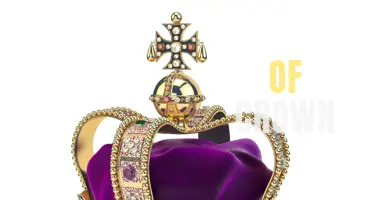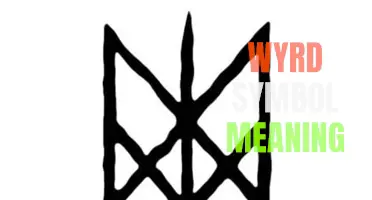
Jewelry symbols have long held significant meanings and have transcended time and cultures. From ancient civilizations to modern society, these symbols adorn our wrists, fingers, and necks, serving as not only beautiful adornments but also as powerful talismans and expressions of our beliefs and desires. Whether it's a delicate heart pendant representing love and affection or a powerful infinity symbol representing eternity and boundless possibilities, jewelry symbols have the power to speak volumes without saying a word. In this article, we will explore the fascinating world of jewelry symbols and their meanings, delving into the rich history and the hidden messages behind these wearable works of art.
What You'll Learn
- What are some common jewelry symbols and their meanings?
- How do different cultures interpret symbols in jewelry?
- Are there any universal symbols in jewelry that have similar meanings across cultures?
- Can jewelry symbols and meanings change over time?
- How can individuals incorporate symbolic jewelry into their personal style and expression?

What are some common jewelry symbols and their meanings?
Jewelry often carries not just beauty and elegance, but also personal and symbolic meanings. Throughout history, various symbols have been used in jewelry to convey messages, express emotions, and represent beliefs. These symbols add depth and significance to the pieces, making them much more than mere accessories. Let's explore some common jewelry symbols and their meanings.
- Heart: The heart shape is universally recognized as a symbol of love, affection, and romantic relationships. Heart-shaped pendants, rings, and bracelets are popular choices to express love and devotion.
- Cross: The cross is a widely recognized symbol in Christianity, representing the crucifixion and resurrection of Jesus Christ. Cross-shaped jewelry such as necklaces and earrings are not only fashion statements but also expressions of faith.
- Infinity Symbol: The infinity symbol, shaped like a sideways figure-eight, represents limitless possibilities, eternal love, and the concept of infinite existence. It is commonly used in necklaces to symbolize never-ending relationships or infinite bonds.
- Star: Stars symbolize guidance, hope, and aspiration. Wearing star-shaped jewelry is often associated with dreams, goals, and inspiration. Stars also represent protection and spirituality in some cultures.
- Tree of Life: The Tree of Life symbolizes growth, strength, and interconnectedness. It is often depicted as a tree with branches and roots, representing the connection between heaven and earth. Tree of Life pendants and earrings are popular choices for those seeking a deeper connection to nature or the universe.
- Hamsa: The Hamsa, also known as the Hand of Fatima, is a symbol of protection and good fortune. The Hamsa hand is believed to ward off evil and bring blessings to the wearer. It is often used in necklaces, bracelets, and earrings as a talisman for protection.
- Om: Om is a sacred sound and symbol in Hinduism, Buddhism, and Jainism. It represents the divine, the universe, and spiritual awareness. Om pendants and charms are worn to promote inner peace and connection to the divine.
- Evil Eye: The Evil Eye symbol is believed to protect the wearer from negative energies and ill intentions. It is commonly used in jewelry as a charm or pendant. The symbol resembles an eye and is often blue, as blue is thought to be a lucky color that wards off evil spirits.
- Lotus: The Lotus flower symbolizes purity, enlightenment, and spiritual growth. In Buddhism, the Lotus is associated with the journey towards enlightenment. Lotus flower-inspired jewelry is often worn to represent personal growth and the pursuit of spiritual awakening.
- Claddagh: The Claddagh is an Irish symbol that represents love, loyalty, and friendship. It consists of a heart held by two hands, with a crown on top. Claddagh rings are popular as engagement rings or friendship rings, with different wear positions indicating relationship status.
These are just a few examples of the myriad of jewelry symbols and their meanings. When selecting jewelry, consider the symbolism behind each piece and choose something that resonates with your beliefs, values, and personal journey. Whether it's a heart to represent love or an infinity symbol for eternal connection, these symbols can enhance the significance and personal connection to your jewelry.
The Meaning and Symbolism Behind the Ansuz Rune
You may want to see also

How do different cultures interpret symbols in jewelry?
Jewelry has always been an important part of different cultures around the world. It is not only a form of personal adornment but also carries deep symbolism and cultural significance. Different cultures have their unique interpretations of symbols in jewelry, which can vary widely. Let's take a look at how some cultures interpret symbols in jewelry.
In Western culture, certain symbols are commonly associated with specific meanings. For example, the heart symbol represents love and affection, while the infinity symbol signifies eternity and endlessness. These symbols are often used in jewelry to convey messages of love, friendship, and commitment. Similarly, the cross is a powerful symbol in Christianity and is widely worn as a pendant or incorporated into other designs.
In Eastern cultures, symbols in jewelry hold different meanings. For instance, in Chinese culture, the dragon symbolizes power, strength, and good luck. Dragon-themed jewelry is often worn during important celebrations or as a talisman for protection. The Chinese also value the yin and yang symbol, representing the balance between opposing forces, and it can be found in jewelry designs as a reminder of harmony and equilibrium.
In Hindu culture, the Om symbol represents the sound of creation and is considered highly auspicious. It is commonly worn in jewelry as a symbol of divine presence and spiritual protection. Another powerful symbol in Hinduism is the lotus flower, which represents purity and enlightenment. Lotus-shaped jewelry is often worn as a symbol of spiritual growth and transformation.
Native American culture has a rich tradition of symbolic jewelry. The use of animal motifs, such as feathers, bears, and eagles, is common and carries spiritual significance. Each animal has its own symbolism and is believed to embody specific qualities. For example, the eagle is associated with strength and courage, while the bear represents protection and healing. Native American jewelry often incorporates these animal symbols to honor their spiritual and cultural heritage.
African cultures also have a wide array of symbolic jewelry. For example, in Maasai culture, beaded jewelry is used to communicate social and cultural messages. Each color and pattern carries specific meanings and can indicate a person's marital status, tribe, or social position. Similarly, in Egyptian culture, various symbols like the ankh (symbol of life) and the Eye of Horus (symbol of protection) are incorporated into jewelry for their mystical and protective properties.
These examples demonstrate how diverse cultures interpret symbols in jewelry. Whether it's a heart pendant, a dragon ring, or a beadwork bracelet, jewelry serves as a visual language that communicates deep cultural and personal meanings. By understanding the symbolism behind different jewelry designs, we can appreciate the rich heritage and traditions of various cultures. So, next time you wear a piece of jewelry, take a moment to reflect on the symbols it carries and the story it tells.
Unlocking the Mystical power of the Harp Symbol: The Deeper Meanings Beyond its Musical Significance
You may want to see also

Are there any universal symbols in jewelry that have similar meanings across cultures?
Jewelry has been an important part of human culture for thousands of years, used as a form of adornment, a status symbol, a means of religious or cultural expression, and even as a form of protection. Throughout history, various symbols have been incorporated into jewelry, each with its own unique meaning and significance. While many symbols may hold different meanings in different cultures, there are a few universal symbols that have similar meanings across cultures.
One such symbol is the heart. The heart shape is widely recognized around the world as a symbol of love, affection, and emotion. It has been used in jewelry designs for centuries and remains one of the most popular symbols today. Whether it's a pendant, a ring, or a charm bracelet, a heart-shaped piece of jewelry is often given as a gift to a loved one, representing the deep emotional connection between the giver and the receiver.
Another universal symbol in jewelry is the infinity symbol. The infinity symbol, a sideways figure-eight, represents eternity, limitless possibilities, and the concept of never-ending love or friendship. Jewelry featuring the infinity symbol is often exchanged between couples, friends, and family members to signify their everlasting bond and commitment to each other.
The cross is yet another universal symbol that transcends cultures and holds religious significance for many. The cross is widely associated with Christianity and represents the sacrifice and resurrection of Jesus Christ. However, the symbol predates Christianity and has been used in various forms by different civilizations throughout history. In jewelry, the cross is often worn as a symbol of one's faith or as a way to remember and honor a loved one who has passed away.
The tree of life is another universal symbol found in jewelry. The tree of life represents the interconnectedness of all living things and the cycle of life, death, and rebirth. It is a symbol of vitality, growth, and strength. This symbol can be seen in ancient mythologies and spiritual traditions from various cultures around the world. Today, the tree of life is often used in jewelry designs, such as pendants and earrings, to represent a connection to nature and the eternal cycle of life.
In addition to these universal symbols, there are also many other symbols that hold similar meanings across cultures. For example, the sun and moon are often used in jewelry to represent the balance between masculine and feminine energies or the duality of light and dark. The lotus flower is another symbol that is recognized in many cultures and represents purity, enlightenment, and spiritual growth.
While there may be slight variations in the interpretations and cultural significances of these symbols, their core meanings remain similar across different cultures. This highlights the power and universality of jewelry as a form of expression and communication, transcending cultural boundaries and connecting people across time and space. Whether it's a heart-shaped necklace, an infinity symbol bracelet, or a cross pendant, these universal symbols in jewelry serve as a reminder of our shared human experiences and the universal values we hold dear.
The Hidden Symbolism of the Black Panther: Unraveling its Meanings
You may want to see also

Can jewelry symbols and meanings change over time?
Jewelry symbols play a significant role in different cultures and societies. These symbols often represent specific meanings and hold great sentimental value to individuals who wear them. Over time, however, the meanings associated with these symbols can change and evolve.
One of the reasons why jewelry symbols and meanings change over time is due to the cultural shifts and societal changes that occur. As societies progress and evolve, so do the symbols and their meanings. For example, a symbol that once represented fertility and motherhood in ancient times may be interpreted as a symbol of feminism and empowerment in contemporary society.
Another factor that can contribute to the change in jewelry symbols and meanings is fashion trends. Jewelry designers often create new designs and incorporate different symbols into their pieces based on the latest trends. These symbols may have new meanings and associations that resonate with consumers' desires and aspirations.
Religious and spiritual beliefs also play a role in the evolution of jewelry symbols. As religious practices and interpretations change, so do the symbols used in religious jewelry. For example, the cross, which is commonly associated with Christianity, has evolved over time to include different variations and interpretations.
In addition to cultural shifts, fashion trends, and religious beliefs, historical events can also influence the change in jewelry symbols and meanings. Significant events like wars, revolutions, and social movements can shape the way symbols are perceived and interpreted. For instance, after the Second World War, the peace sign became a popular symbol for pacifism and anti-war sentiment.
It's important to note that while jewelry symbols and meanings can change over time, their original significance and historical context still hold value. Symbols carry with them a rich history and cultural significance that should be acknowledged and respected.
In conclusion, jewelry symbols and their meanings can indeed change over time. Cultural shifts, fashion trends, religious beliefs, and historical events all contribute to the evolution and reinterpretation of these symbols. However, it is crucial to recognize and appreciate the original symbolism and historical context associated with these symbols, as they form an integral part of our collective human history.
Exploring the Meaning and Importance of Field Weld Symbols
You may want to see also

How can individuals incorporate symbolic jewelry into their personal style and expression?
Symbolic jewelry can be a powerful way for individuals to express their personal style and beliefs. Whether it's a necklace with a meaningful pendant or a ring with a special engraving, symbolic jewelry can serve as a visual representation of one's values, faith, or interests. With so many options available, it can be overwhelming to incorporate symbolic jewelry into your personal style. Here are a few tips on how to do so effectively:
- Choose a Symbol with Personal Meaning: Symbolic jewelry often carries specific meanings or messages. Before purchasing a piece, take the time to research and select a symbol that aligns with your personal beliefs or experiences. Whether it's a religious symbol, a geometric shape, or an animal motif, make sure that it holds some significance to you.
- Layering and Stacking: One popular way to incorporate symbolic jewelry into your personal style is to layer and stack different pieces together. This technique adds depth and dimension to your look while allowing you to showcase multiple symbols at once. Start by selecting a few key pieces that hold personal meaning, and experiment with different combinations until you find a layered look that feels authentic to you.
- Mix Metals and Materials: Don't be afraid to mix metals and materials when it comes to symbolic jewelry. Combining different textures and finishes can add an interesting contrast to your overall style. For example, pairing a delicate silver pendant with a chunky gold bracelet can create a unique and eye-catching look. Experiment with different combinations to find the right balance for your personal style.
- Make a Statement: Symbolic jewelry is meant to be noticed, so don't be afraid to make a bold statement with your pieces. Whether it's a chunky necklace with a large pendant or a stack of multiple rings on one finger, embrace the power of symbolism by choosing pieces that command attention. Just remember to keep the rest of your outfit relatively simple to let the jewelry take center stage.
- Wear with Confidence: Ultimately, the most important aspect of incorporating symbolic jewelry into your personal style is to wear it with confidence. Embrace the meaning behind your chosen symbols and let them serve as a reflection of your authentic self. When you wear symbolic jewelry with pride, it becomes a powerful tool for self-expression and can spark conversations and connections with others who share your beliefs or interests.
Incorporating symbolic jewelry into your personal style and expression is a creative way to reflect your values and interests. By selecting meaningful symbols, layering and stacking pieces, mixing metals and materials, making bold statements, and wearing with confidence, you can create a unique look that showcases your individuality. So, go ahead and explore the world of symbolic jewelry, and let your personal style shine through.
The Symbolic Meaning Behind the Heart with Star Symbol
You may want to see also
Frequently asked questions
The infinity symbol, which looks like a sideways figure-eight, represents eternal love and limitless possibilities. It is often used in jewelry to symbolize a never-ending bond or connection between two people.
The heart symbol is commonly associated with love, affection, and emotions. In jewelry, a heart-shaped pendant or charm is often given as a symbol of love and can represent deep affection or romantic relationships.
The tree of life is a powerful symbol in many cultures and religions. In jewelry, it can represent growth, strength, and interconnectedness. It is often seen as a symbol of fertility, abundance, and the cycle of life.
The evil eye symbol is believed to protect the wearer from negative energy and bring good luck. It is often found in jewelry in the form of a blue eye-shaped charm or pendant. The evil eye symbol has been used for centuries in various cultures to ward off evil spirits and protect against misfortune.
The lotus flower is a symbol of purity, enlightenment, and spiritual awakening. In jewelry, it can represent beauty, grace, and the ability to rise above challenges. The lotus flower is often depicted in jewelry as a blooming flower or a closed bud, symbolizing the journey of personal growth and transformation.







